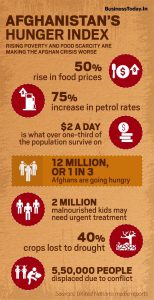By: Arjan Capital Ltd, London

 Arjan Capital Ltd. is a financial advisory company in multidisciplinary sectors and industries focusing on payment solutions. Headquartered in London, we are authorized and regulated by the UK Financial Conduct Authority (FCA).
Arjan Capital Ltd. is a financial advisory company in multidisciplinary sectors and industries focusing on payment solutions. Headquartered in London, we are authorized and regulated by the UK Financial Conduct Authority (FCA).
We assist international companies with their transactions and dealings around the globe, including complex markets like Afghanistan, Iran and the like.
Part of our routine is to unravel opacities like what the Afghan nation is currently experiencing. Not long ago, new rulers took over all levels of politics, government, and society. Our job is about analyzing financial issues of all sizes and subjects for the benefit of our clients’ businesses and the enhancement of our proprietary investments in the region.
The following summary is crafted to closely examine and describe the current commercial environment, financial opportunities, and obstacles in Afghanistan. This report should be neither read nor interpreted as opinions of the writers on political, strategic, or religious issues of Afghanistan or countries named herewith.
The worsening of Afghanistan’s steadily declining economy is everywhere in the headlines after the Taliban took control of the country’s affairs in mid-summer of 2021. Afghanistan was already heavily affected by insecurity, corruption, drought, and government mismanagement, resulting in declining revenues. The Afghan economy is now facing further challenges after the Taliban takeover and the international community’s withdrawal of aid and assistance. It will be primarily the actions of the newly formed Government of Afghanistan that will decide the fate of the economy of Afghanistan going forward and, most importantly, the international community’s winners and losers in this scenario.
A few bullet points of facts:
- The conquest of Afghanistan by the Taliban led to:
- Countless Afghan people fleeing the country,
- Freezing of approximately USD 9bn of the nation’s foreign reserves by a multilateral group of governments and the United States of America,
- Halting of crucial development projects impacting the country’s economy.
– The country’s lithium reserves – a key component in batteries (mobile phones, cars, renewable energy) – and its exporting industries, agriculture and minerals are of strategic interest to compete for by industrialized economies from West to East.
– There are long lines of depositors concerned about current banking operations and restrictions
– Weekly withdrawals are limited per account to 20,000 Afghanis (ca.US$ 200) to control the country’s dwindling domestic cash reserves .
– Dr Fawaz Gerges, Professor of International Relations at the London School of Economics (LSE), commented on BBC News :
– “It doesn’t matter if you have Afghani currency because that money has lost most of its value. And the central bank, the resources, and the assets that helped sustain the Afghani currency have been frozen. “
– “It seems that the Western powers and the US are willing to do what is called conditional engagement – that is, that the Taliban have to behave for the international community to unfreeze Afghanistan’s foreign reserves and allow the Taliban access to Afghanistan’s central bank’s assets.”
– “I think it’s in the self-interest of the Taliban to provide goods and services for the Afghan people, to show that they are now in control, that they are a functioning government, and that they mean it when they say that they have changed.”
Taliban spokesman Zabihulla Mujahid said recently that the group wanted to make Afghanistan a “narcotics-free country” and appealed for international assistance to “revive our economy.”Assessing the overall situation in Afghanistan under the current conditions
A nation is considered aid-dependent when at least 10% of its GDP comes from foreign aid .
In Afghanistan, this number is around 40%, which confirms the fragile economic condition of the country even before the shift in power on August 15th, 2021, when
after 20 years, the Taliban took back control. Although they don’t face any immediate military opposition, the current humanitarian crisis can further worsen with an economy and a financial system on the brink of collapse.
Foreign Reserves:
Afghanistan’s foreign currency reserves are deposited outside the country. Vital for Afghanistan’s economic survival, they are, at least for the moment, not within reach of the new Taliban government.The Taliban of August 2021 is trying hard to smooth talk the world that it is a reformed organization with a different mindset from 20 years ago. Their claims picture a new tolerant and inclusive government replacing the harsh rules and draconian punishments of the Taliban that the world remembers from 1996. Only time will tell, of course, and the world community is, for now, watching closely how this narrative unfolds.
The financial sector and its issues:
Afghanistan features high on the list of the most dependent countries on foreign worker remittances. Many Afghan families have depended on these international money transfers sent home by their migrant working members for decades. The loss of institutions like Western Union or MoneyGram that helped the circulation of remittances is a severe blow to a failing economy and can further accelerate its collapse.
According to the World Bank, 50% of Afghanistan’s population lived below the poverty line before the regime change. With the foreseeable collapse of the economy, this figure is expected to rise sadly.
Comments by Dr. Nasser Saidi, Middle East economic expert, about the current situation in Afghanistan
● “Macro-economic stability cannot be maintained in the short term [in Afghanistan]. In the medium to long term, if there is a political settlement and relations are re-established with the US, Europe and the Gulf states, they can begin to stabilize.”
● “China and a few other Eastern countries are most likely to seize financial and strategic advantages under the new Taliban Government. Reliable payment systems are vital to functioning business and trade.”
● “With reserves frozen, remittance channels disturbed, paper money limited and running out, a lot of uncertainty prevents regular business for the time being.”
● “I anticipate agreements with China to exploit Afghanistan’s natural resources. In that case, China will benefit from the debacle of the US withdrawal,”
● “It will not come in the form of aid, but investments [will be] in infrastructure and exploitation of natural resources. If Afghanistan is linked to the Belt and Road Initiative, the economic situation could improve dramatically,”

↑Figure1: Afghanistan: Taliban face a financial squeeze from West

↑Figure 2: Total remittances into Afghanistan in USD( Millions) (2012-2020)

↑Figure3: key economic indicators for Afghanistan, 2021
The above table features the countries and organizations that, having supported Afghanistan for decades, are now either freezing its foreign assets or suspending aid to the country.
How will Afghanistan’s economy be impacted in the foreseeable future?
Decades of occupation and war, wrapped in exuberant foreign aid during that period, distorted Afghanistan’s GDP and seeded a fertile swamp for corruption and unclear economic expectations. An entire generation was raised on a financial concept of aid and assistance rather than production of goods and services. Similarly, the brutal suspension of that same foreign aid created a tectonic shift for the economy. This void will disorient and deprive a large part of the population of their livelihood in a country which is in serious debt for servicing the needs of its former foreign occupants. Afghanistan requires a new economic raison d’être and a fresh start removed from the poppy seed industry, which grew out of hand under US occupation.
Nature abhors a vacuum, concluded Aristotle, the Greek philosopher. Aristotle’s inference was that religion could fill such a vacuum. In the absence of European support, Afghanistan’s financial emptiness echoes not so much of faint Chinese economic tunes but rather of religious siren songs.
What are investors looking for?
In general, the behavior of a government, the rule of law and containment of corruption are decisive factors for any institutional frontier market investor. This holds even more true in current-day Afghanistan, with an unknown government ruled by inexperienced administrators.
Afghanistan’s mineral wealth:
According to a recent US geological survey , Afghanistan has significant untapped resources and vast copper, iron, and cobalt deposits. The economic ace up the Taliban sleeve is the country’s rich mineral and mining resources. Economists value these deposits between US$1- 3 trillion . Over the last twenty years, several geological surveys have been concluded according to which the country is rich in minerals and natural resources like copper, gold, oil, natural gas, uranium, bauxite, coal, iron ore, rare earth elements, lithium, chromium, lead, zinc, gemstones, talc, Sulphur, travertine, gypsum, and marble. This is undoubtedly a tempting list for foreign political, military, and private sector interests.
The US Department of Defence did a geological report in 2010 that described the country as the “Saudi Arabia of Lithium.”
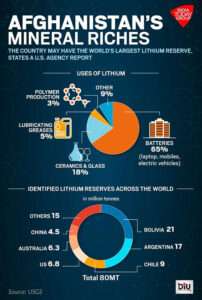
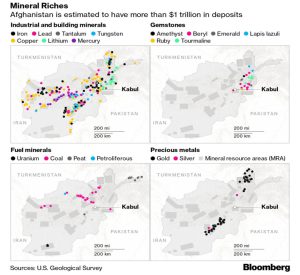
Figure4 Figure 5-1
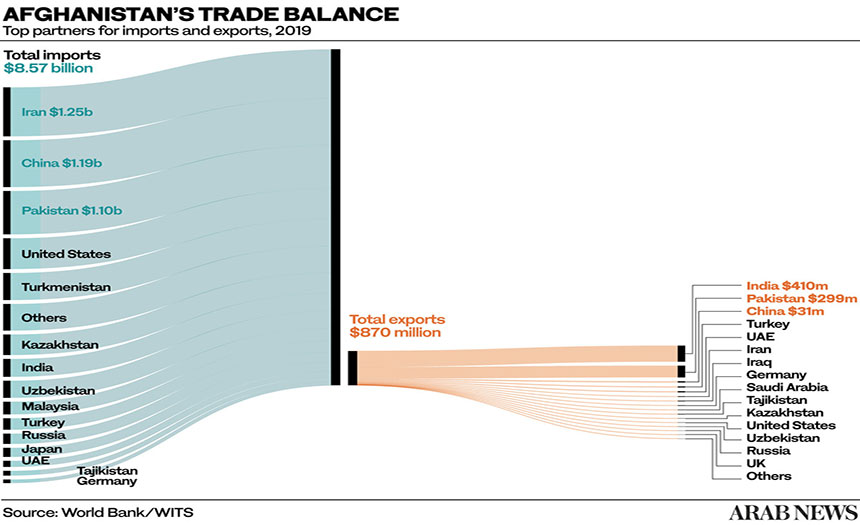
Figure 5-2
The way forward: a chance to save Afghanistan?
The Taliban of 2021 well understand that today’s Afghanistan is a different country from that of 1996. During the past 25 years, Afghanistan’s people enjoyed some form of freedom under US protection, and an entire post-war generation grew into adulthood with high hopes and expectations. For the new rulers of the country, a collapsed economy, ongoing rampant humanitarian crisis, and most importantly, lack of foreign private sector investments will not cement political power.
Coverage of current conditions in Afghanistan points in only one direction. The fact is that the UN must intervene and work on human rights agreements and assure that the Taliban fulfil the commitments they made after taking power in that country. Education for girls, women empowerment, and human rights are high on the list, as unlikely as they may sound under a rigid Islamic regime.
As a trade route that links the country with Southeast Asia, Afghanistan certainly has a chance to become economically viable. The Chinese Belt & Road initiative is the most likely lifeline for Afghanistan when it most needs foreign trade and commerce. Trade today already contributes to more than 50% of Afghanistan’s GDP.
In 2020, India traded $1.5 billion worth of goods with Afghanistan. This included 85% of India’s dry fruits which come from Afghanistan. At the same time, Pakistan is the largest trade partner of Afghanistan, while China’s trade with the country is only about 11% of Pakistan’s trade with Afghanistan.
Importance of Managing trade and imports
● Afghanistan’s economy is not balanced. The main problem is the country’s near-total dependence on imports.
● The country does not have much domestic manufacturing. Most fast-moving consumer goods (FMCG) are imported.
● Afghanistan must rely on food imports even to feed its population.
● 80% of total electricity consumption is imported.
Such dependence on imports is a strategic worry for any leadership. The way to secure a minimum of economic stability and contain humanitarian crises is a stable trade flow
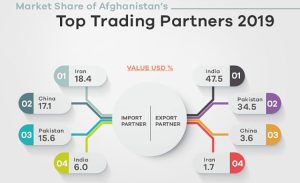
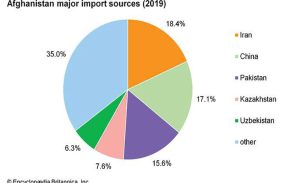
Figure6 Figure7
The winners and losers in Afghanistan today:
● Shortly before the Taliban took over Afghanistan in mid-August, most West European countries closed their embassies in Kabul and evacuated their staff.
● Embassies of regional countries like Pakistan, Iran, Qatar, Russia, and China remained open.
● The biggest winner of the current situation, Pakistan, announced an economic and trade framework with Afghanistan on September 9th, 2021.
● Pakistan is openly showing its great interest in bilateral trade with Afghanistan – and will ideally impose its currency on Afghanistan.
● China is preparing to invest in Afghanistan’s infrastructure and mineral-related projects.
● Western countries and foreign aid partners have backed off from Afghanistan. Asian partners are ready to step in and help Afghanistan come out from the deep economic and humanitarian crisis at a yet unknown cost to Afghanistan.
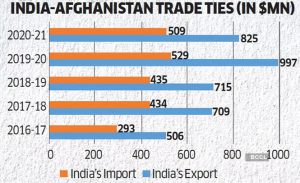
Figure8
The practical and commercial side of the crisis:
Afghanistan is a firmly cash-based society where entire truckloads of high-value commodities like oil change hands against suitcases full of banknotes. Bartering, or non-cash business, may look like an option but it demands high-value exports to be made logistically practical.
Cash shortage, meanwhile, is a severe economic fallout in a politically unstable environment that requires immediate remediation. When the US invaded Panama in 1989, for instance, they tried hard to dry up the supply of US dollar banknotes which is the country’s de facto legal tender, and is locally called Balboa (one Balboa is still equal to one USD). As a result, millions of dollars of cash left homes and businesses, stashed outside the country to be safely protected from the official banking system which served only as a money laundering medium for the rich and powerful. Likewise, billions of Deutschmarks from the pre-Euro times are still hoarded in German households, remaining valid legal tender forever. One could expect similar amounts of Afghani notes and probably US dollars stored in Afghan homes and institutions. In the short term, to remedy the shortage of physical cash, Afghanistan can turn to its neighbours for an instant print of Afghanis. But the issue of inflation will need to be addressed in this context.
Arjan Capital proposed to the previous government to organize a commodity-backed bond with assets secured in a reputable bonded warehouse in Dubai or Switzerland as physical collateral against investors’ money. The most fungible asset is gold, and Afghanistan has plenty of it. Gold enjoys worldwide predictable demand at an established market price. In instances of non-payment, the investor can swiftly liquidate the gold asset and recover the investment, including the agreed margin. Other commodities like gems, of which Afghanistan also owns a good quantity, are possible though more complex to lend against and liquidate in non-payment cases.
Afghanistan provides an opportunity for the long-term strategic investor to buy into industrial manufacturing, FMCG production and distribution of renewables once feed-in tariffs and payment systems are reconfirmed. For the immediate, Arjan Capital’s favorite choice of investment remains collateralized short term trade financing. Even today, there is some credit insurance available for Afghanistan.
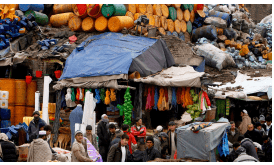
The Iran-Afghanistan relationship:
● Iran almost went into war with the previous Taliban government back in 1998. The situation is no longer the same.
● Today Iran is one of the largest and most important trading partners of Afghanistan, holding talks with the Taliban.
● After the US departure from Afghanistan, Iran’s application to become a member of the Shanghai Cooperation Organization got approved. This approval of membership, where Afghanistan has observer status, is crucial for Iran to play its role in dialogues on regional security, especially after the Taliban takeover in Afghanistan.
● With Iran still suffering from US sanctions, maintaining a good trading relationship with Afghanistan helps Iran get much-needed currency.
● Iran hosted millions of Afghan refugees in previous years. It is now getting more reluctant to take this burden. It is the new Taliban government’s responsibility to maintain peace within Afghanistan
● According to various news insights, Iran’s initial expression after the US left Afghanistan was celebratory on one side while at the same time keeping a close eye on the actions of the newly formed transition government, which will decide on the strengthening or weakening of the current relationship.
● Most importantly, Iran is taking a substantial interest in collaborating with China and Russia in Afghanistan, which are keen to fill the void that the US left to harvest economic benefits from trade routes and mineral extraction.
Concluding thoughts:
Most will agree that the proverbial Afghan glass looks very much half-empty at best.
Where can one find the optimism to see it half-full? Hope dies last, and with Afghanistan, hope must not die.
The Afghanistan banking system is suspended due to the abrupt internal power shift, not unlike what Iran is experiencing from international sanctions. In Afghanistan, the doomsday scenario is that the lack of funds will freeze the economy, provoking a default of the current financial system with a meltdown of the local banks as a final consequence. Social unrest will undoubtedly follow. This scenario may be averted due to the significant commercial interest in Afghanistan from India, China, and Pakistan. Pakistan, and maybe China, will also prevent such a meltdown of the Afghanistan financial system in their own interest. The price tag for Afghanistan of such economic help is unknown yet but might come cheap in the long run if it guarantees peace and stability. It remains to be seen how much of such support the new Afghan government wishes to accept.
